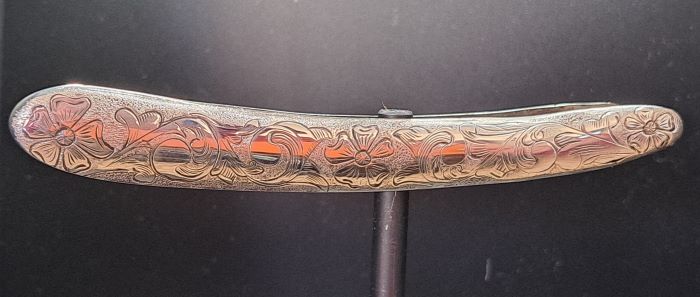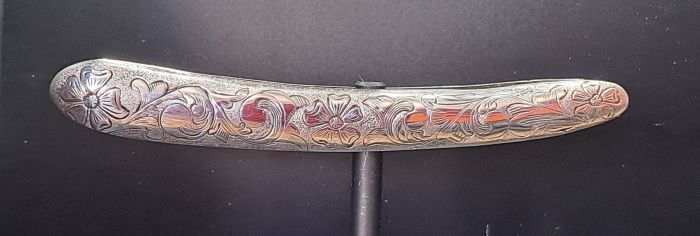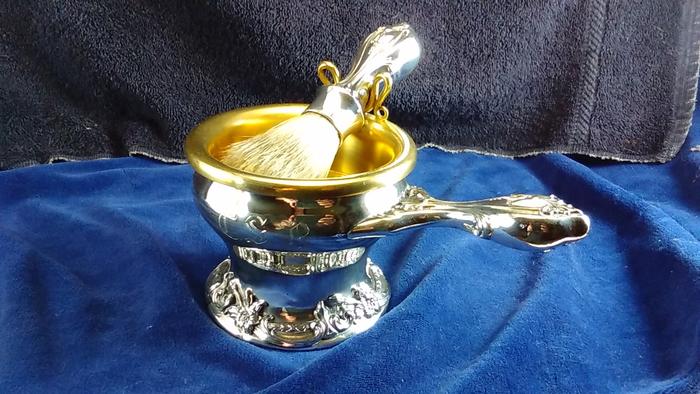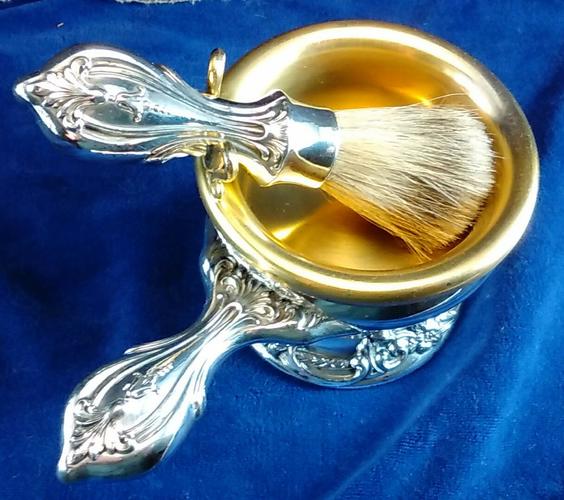Results 1 to 10 of 11
-
01-09-2024, 12:04 AM #1Junior Member

- Join Date
- Jan 2021
- Posts
- 7
Thanked: 3 Sterling Silver Scales, hand engraved pattern
Sterling Silver Scales, hand engraved pattern
These scales I made from sterling silver.
Hand engraved a pattern on two 1"x6" pieces of sheet sterling to be similar on both sides. Then formed, cut, soldered and polished.




-
The Following User Says Thank You to rtom2809 For This Useful Post:
markbignosekelly (01-09-2024)
-
01-09-2024, 01:00 AM #2

Du-Uu-Uu-de! That's 2 double u worthy.
Awesome work.Iron by iron is sharpened, And a man sharpens the face of his friend. PR 27:17
-
The Following User Says Thank You to PaulFLUS For This Useful Post:
rtom2809 (01-09-2024)
-
01-09-2024, 01:02 AM #3

You do some nice work. Have you ever thought about a scuttle, and brush. Just curious of your talents.

 Mike
Mike
-
01-09-2024, 01:08 AM #4
-
01-09-2024, 01:41 AM #5
-
01-09-2024, 02:30 AM #6
-
01-09-2024, 12:56 PM #7
-
01-09-2024, 02:29 PM #8
-
01-09-2024, 04:50 PM #9

Would never think he could replicate it. Just a cool, silver scuttle of his own design. The pic is just food for thought.
Mike
-
01-09-2024, 08:54 PM #10Junior Member

- Join Date
- Jan 2021
- Posts
- 7
Thanked: 3
That is beautiful! Although the short answer though, is no.
I have thought of brushes, and strop ends/handle. Never thought of a scuttle.
The example you provided would solve one hangup I have on the brush, to have a flat end, for where to put it while being used. Also, not being round, cylindrical shaft is a plus.
I've focused on mimicking a turned handle; flat end to rest counter top, hourglass shape to grip, being round, with a pattern on the sterling. To have each of those qualities, would either take additional equipment, an irresponsible amount of time, or shorting one of those qualities. The example shown, doesnt have a flat end, or a round body, so that lends to being more reasonable. Then the scuttle, hand hammering a bowl for a scuttle also takes a lot of time, or additional equipment.
So that long answer is, no, not something I would do currently, and do not see near future getting the equipment or desire to do it.
What The example does show, that I'd like to duplicate to consistent production type results, is a deep relief pattern which mimics repousse and chase work.
To do as repousse takes some time. Not just because of the tapping out the design, but just heating, cooling and cleaning the pitch, the work surface you set the metal in. Outline with tracers punches from the front, repousse from the back, chase the front, return to the back, and return to the front. Ideally pattern done now, but may have to work back or front some more. Each of those transitions of working front or back, need to heat the pitch up for metal to release, clean the pitch off metal, anneal the metal, re-warm the pitch, set metal in pitch and let cool down, before can start working again. It is satisfying, and meditative, but not something to complete on a Saturday.
To streamline, is to make a die, using it on a hydraulic press. The cutler's that made sterling scales, and the example Outback posted, was done by making a master hub hob, the male version of the project, using that hob to make the female, then that female die to make matching working male, placing in a shoe to keep aligned, and stamp out product.
That's more equipment and space than reasonable to keep as fun project. What is manageable, is carving a female die, then using lead or urethane in place of a male die on the hydraulic press. Takes a few passes, doing about 1"x1" sections at a time, repeat, annealing each pass.
Carving flat piece of steel, is easier than concave section, such as the curve of scales. So pattern imprinted on flat sterling first, then form the kidney shaped scales convex, using an impression die.
Carving the flat steel, to make the female die, has its own limits. Cutting flourishes the opposite of what want the stamped item to look like, has its own challenges. Using engraving tools, and burrs, cutting something convex that will stamp as concave can get tough.
SO, deep relief pattern is some work, and once have all that work, would have lots of time and money into it, so I'd have to want to make lots of them. No matter how pretty, I wouldn't want 50 razors with the same scales.
Other options for the pattern then are negative relief, no pattern, shallow/low relief, and medium relief.
negative relief
Pros-Engraving, is what this would be. Fun to do. Hand engraving, will use different cut angles, and that really makes it sparkle in light.
Cons- Takes a few hours to cut. Could laser cut, but then lose the sparkle of cutting angle
No pattern
Pros-Plain and simple
Cons-Surprisingly, takes longer than imprinting a pattern, due to every scratch and ripple seems as if front and center
Shallow/low relief
Pros-Rolling mill* imprinting some sort thin media to the silver. Endless options of texture, like lace, fabric, leaves, etc. Laser etching of paper is inexpensive, making easy way to apply custom art
Cons-Cant really polish to mirror, because imprint not high enough to be retained after even minimal abrasion. Imprint is 2D; being raised or low. Can't have transitional heights, other than the edge going high to low
Medium relief.
Pros-Rolling mill* Imprinting some sort metal plate's pattern to the silver. This is the easiest and quickest way to imprint, with satisfactory results. High spots can be polished, low spots not. Many pattern/texture plates available from jeweler supply vendors. Can make own, such as acid etching or engraving mild steel 1/8" thick steel plate. 2"x7" fits scales well, and common size from vendors.
Cons-Imprint is 2D; being raised or low. Can't have transitional heights, other than the edge going high to low. (cant make a concave flourish)
*Rolling mill for jeweler looks sort of like a hand crank towel wringer. Instead of rubber rollers, has metal rollers. As example, to texture sterling, I'll anneal a 2"x6" piece of 24 gauge sheet sterling. Select a texture plate, sandwiched together. Place those in the mill, tightening until roller just hold the sandwich. remove the sandwich. tighten the rollers down a bit more, then roll through, which imprints the pattern on to the silver.
-


 27Likes
27Likes LinkBack URL
LinkBack URL About LinkBacks
About LinkBacks






 Reply With Quote
Reply With Quote



